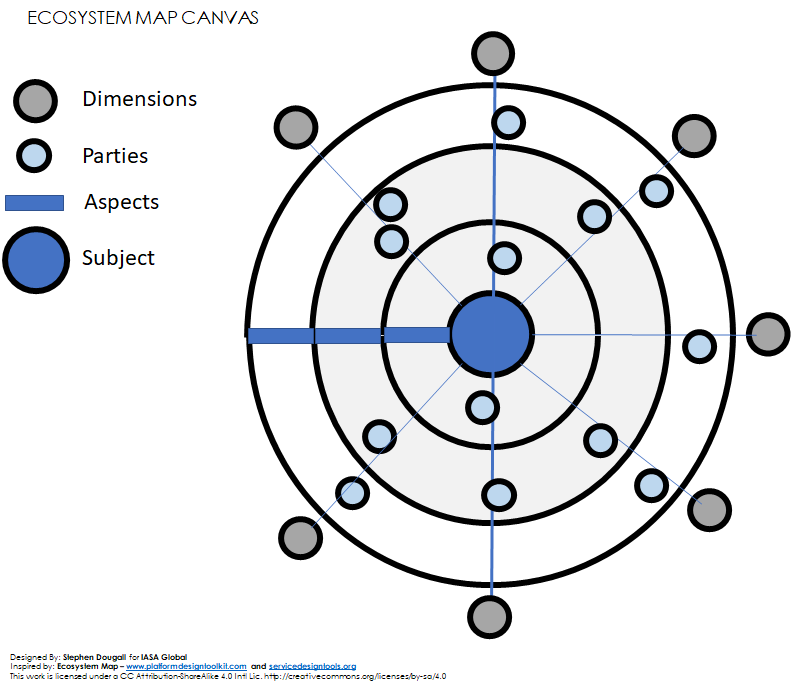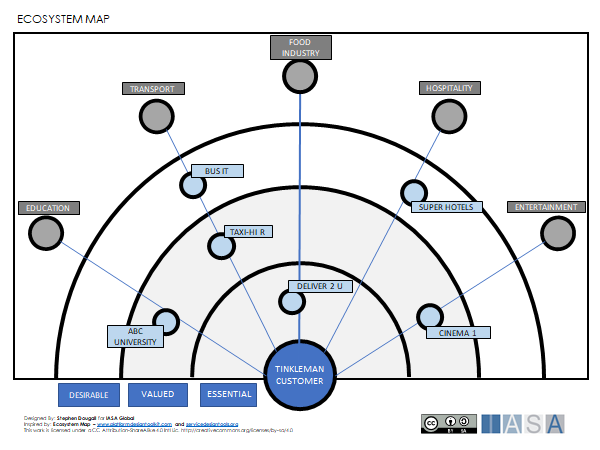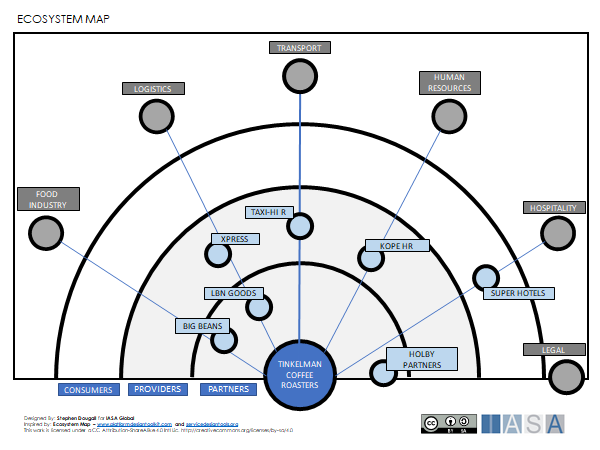“A group of businesses or business activities that affect each other and work well together” definition of Ecosystem, Cambridge Dictionary
What is the Ecosystem
The Ecosystem represents the external environment within which an organization participates, interacts and is affected by other parties in the ecosystem. Typical parties in an ecosystem are:
- Suppliers and Partners
- Customers
- Investors (owners and long-term lenders)
- Competitors
- Government Agencies
- Communities
- Employees
An ecosystem may be created by design, or may naturally evolve and grow as a consequence of innovation. Ecosystems are adaptive, self-organizing and scalable, they are loosely coupled and there is no explicit control of the parties in the ecosystem. By nature they are complex disordered systems and will change over time due to internal and external forces.
The interaction or collaboration of parties in the ecosystem creates value streams which provide opportunities. When value increases the ecosystem grows, and when value decreases the ecosystem retracts, this may result in the ecosystem being overtaken by another ecosystem with greater value.
In this article ecosystems are considered from two perspectives, the ecosystem surrounding the customer, and the ecosystem surrounding the organization.
Why the Ecosystem is important
It is important for the architect to understand the ecosystem in order to uncover opportunities and mitigate risks. Understanding how an organization provides value for its customers provides the basis for innovation and optimization of operations. The strategies and decisions an organization has made to integrate with the ecosystem are a key factor in forming an architecture. Architects who ignore the ecosystem risk missing constraints or opportunities when developing the architecture.
The ecosystem opens business opportunity through collaboration with other parties. This provides a basis for innovation, where different parties in the ecosystem can collaborate to create new forms of value, such as products and services. As an example, consider the following statement from Jack Ma, Founder of Ali Baba.
“Our philosophy is that we want to be an ecosystem. Our philosophy is to empower others to sell, empower others to service, making sure the other people are more powerful than us. With our technology, our innovation, our partners – 10 million small business sellers – they can compete with Microsoft and IBM.” - Jack Ma, Founder Ali Baba
Understanding the effect of events within the ecosystem and how they affect the organization and its value chain (or value streams) is important to reduce business risk. This understanding is critical in making business and technology decisions, for example, it may be the difference between choosing the right or wrong partners for the organization’s services.
All parties in the ecosystem are influenced and affected by internal and external events. It is therefore important to understand the relationships in the ecosystem, in order to assess the effect of such events on the organization. Understanding the effect of these events is key in reducing business risk and taking advantage of opportunities. For example, ensuring the timing is right for joint ventures, or the selection of technology partners.
Regular reviews of the organization’s product or service strategies against the ecosystem is good practice and supports sustainability.
Ecosystem Approach
Understand the Customer Journey
In order to understand the ecosystem it is important to understand the customer journey, including the customer interaction with parties external to the organization. This provides the basis for potential collaboration and an understanding about how parties can work together to provide a greater value for the customer. For example, when a customer purchases a car, the car dealer has a partnership with insurance companies, so the car dealer can help the customer sign an insurance contract at the time of purchase.
Modular or Integrated Relationships
When an organization develops its business model, it is important to understand the strategy for interaction with the ecosystem. This can be expressed as a modular or integrated approach. A modular approach means that the organization provides services which are very loosely coupled to other parties in the ecosystem, rather like providing a platform of services which can be used by many parties. An integrated approach means that the organization provides services which are tightly bound to parties in the ecosystem, rather like a supplier of parts to a specific make of aeroplane.
This choice of module or integrated is not binary, it is rather a question of how modular or integrated an approach the organization wants to pursue.
Customer and Organization form Powerful Intersections
When mapping the ecosystem from the organization and customer perspectives, look for parties in the ecosystem which feature in both perspectives. These parties may provide powerful opportunities to gain capabilities and make operations more efficient, while at the same time creating added value for the customer.
Maximize Opportunities, Reduce Risk
Understanding the relationships in an ecosystem provides the knowledge needed to anticipate the negative, and positive effects of events in the ecosystem. This allows an organization to quickly take advantage of opportunities, but also helps to identify risks and mitigate them.
Ecosystems from the Customer Perspective
An organization may have several types of customers consuming different types of services or products. The consumption of the service or product, from the customer perspective, may require the use of other services or products in order to fully satisfy the customer’s needs. For example, when a customer needs a Car Dealer to perform a service on their car, there is a need to supply technical information about the car, and perhaps the customer needs a hire car while the service is being performed. The supply of technical information and the provision of a hire car are perhaps services which are provided by other parties in the customer ecosystem.
Understanding the ecosystem from the customer perspective allows the architect to consider opportunities for connecting services from different parties, or creating services which provide a better experience and added value for the customer.
Ecosystems may also be born out of major innovations. A disruptive service or product which changes or creates a market or industry. For example, the introduction of smart phones. These innovations often have a customer centric perspective, the following are examples of the thinking which changed or created ecosystems:
-
Henry Ford (Ford) asked, “What would enable everyone to have a car?”.
-
Steve Jobs (Apple) asked, “What would enable everyone to have a computer?”.
-
Akio Morita (Sony, The Walkman) asked, “What would enable young people to have their own music”.
-
Jeff Bezos (Amazon) – “What would cause people to do their shopping online”.
In the customer ecosystem we also want to consider the competitors to the organization and their influence on the ecosystem.
Ecosystems from the Organization Perspective
The customer perspective looks at the ecosystem through the eyes of the customer, but many organizations have relationships with parties which are invisible to the customer. These are the parties in the ecosystem which provide essential business services and products required for an organization to deliver value, and may even be essential to business operations. This can perhaps be thought of as the organization outsourcing a capability that is required in order to deliver its products and services. For example, a car manufacturer has a relationship with suppliers of various car parts, companies providing raw materials (such as steel), and car dealerships.
This is an important perspective for the architect to consider, in order to ensure that the business is continuously operational, and to optimize operations and value delivery.
Changes in the ecosystem can have a major effect on the ability of an organization to deliver its products or services, and in turn initiate significant changes to an architecture. A typical example of this is regulatory or legal changes such as the introduction of GDPR (General Data Protection Regulation) which had an effect on software suppliers, cloud providers, and the processes by which organizations manage data.
Analyzing the Ecosystem
An ecosystem can be viewed from many different perspectives, and each organization will have its own set of interests in the ecosystem. Therefore, the model used for analyzing the ecosystem has to be flexible enough to fit different types of organizations, and different types of customers.
The following is an Ecosystem Map Canvas, it shows an ecosystem, rather like a universe of different parties around a particular Subject.
The ecosystem map consists of four concepts:
-
The Subject – this is the perspective from which the ecosystem is seen, for example, the customer, the organization, or part of an organization.
-
Parties – these are the different parties which are active in the ecosystem, for example, actual companies, customers or suppliers.
-
Dimensions – this groups parties together based on a common characteristic, for example, industry or market sector
-
Aspects – these are the rings in the diagram, and are how the subject perceives the parties, for example, provider, consumer or partner. The rings can be used to indicate the strength of the relation, from the inner most ring out.
The ecosystem can be analyzed from the customer perspective, or the organization perspective, by placing the customer or organization as the subject. To start the analysis the subject must be chosen first.
There are several different ways to work with this canvas depending on how much information is known about the ecosystem. It is good practice to decide on the aspects before placing parties on the map, it is the aspects which make the ecosystem meaningful for the subject, and drive which parties will be shown on the ecosystem. A good starting point for aspects is the following:
| Organization Perspective | Customer Perspective |
|---|---|
| - Partner- partners to the organization - Provider- service or product providers to the organization - Consumer - a consumer of the organization services or products |
- Essential - parties essential to customer satisfaction - Valued - parties the customer finds valuable - Desirable - parties which improve the customer experience |
These aspects are not perfect, it is possible that parties may be both a Provider and Consumer, or provide services which are Essential and Desirable. It is up to the experience of the participants to place parties in the aspect which fits best.
Dimensions can be added before placing parties on the ecosystem map, or parties can be added to the ecosystem and then grouped into dimensions. The dimensions are a common attribute shared by parties, and the way to work with the analysis may depend partly on the purpose of the analysis. For example, to find parties in a particular dimension, or to map existing parties into dimensions. For both the organization and customer perspectives a good starting point is to work with industry sectors, for example:
-
Retail
-
Manufacturing
-
Government
-
Hospitality
-
Logistics
-
Transport
The dimensions are likely to be specific to the type of business the organization works with, or the scenario of the customer.
In the case of aspects and dimensions, it is up to the participants to decide the number of dimensions or aspects to be used. However, mapping large numbers of aspects and dimensions can create a complex model, it is recommended to use a limited number of aspects (max 4.) and dimensions (max. 8) on a single map, and create several maps from different perspectives if required.
The parties are placed in the aspects and dimensions. The parties are the actual entities with which the customer or the organization interacts. These may be companies, government agencies, NGOs, or interest groups.
Mapping and analyzing the ecosystem can provide valuable insights to relations, services and opportunities. It can highlight potential for collaboration, and draw attention to the really important parties in the ecosystem.
In order to further illustrate the ecosystem map canvas, the following examples show a map from the customer perspective and the organization perspective.
The Tinkleman Customer
The following example uses a fictional “Tinkleman Coffee Roasters” company, where the subject is a customer to a Tinkleman Coffee Shop. In this ecosystem, the aspects essential, valued, and desirable are used to indicate how important the parties are to the customer. Several dimensions have been identified in the ecosystem which provide services or products to the customer when they want to get a cup of Tinkelman coffee.
In the above map, notice that the customer values transport to the coffee shop, in particular through the taxi service company “TAXI-HI R”, and other customers prefer to have their coffee delivered home, via the “DELIVER 2 U” order and collect company. Customers who are students at the ABC UNIVERSITY value access to Tinkleman Coffee during their studies, hopefully close to the campus. Customers at the nearby Super Hotel often order coffee for conferences or meetings, and some customers often pick up coffee on their way to see a film at the CINEMA 1 complex. In this example, we can see a number of opportunities for Tinkleman to increase value to the customer by working with other parties in the ecosystem.
The Tinkleman Company
The following example uses “Tinkleman Coffee Roasters” company as the subject. In this ecosystem, the aspects partner, producer and consumer, are used to indicate the relationship between Tinkleman and the parties. Several dimensions have been identified in the ecosystem, which perhaps represent types of business, but may also represent capabilities which are of interest to Tinkleman.
In this ecosystem there are a number of partnerships with several companies, BIG BEANS for provision of coffee beans, LBN GOODS for logistics from the roasting facilities to the coffee shop, and HOLBY PARTNERS who help with legal administration.
KOPE HR human resources company regularly provide Tinkleman with recruitment services for barista personnel. The TAXI-HI R company provides a taxi booking service to Tinkleman for both staff and customers, while XPRESS provide logistics services on a request basis. The SUPER HOTELS chain are a consumer of Tinkleman Coffee for their conferences.
In this example, there are opportunities to improve the operation of the organization. Perhaps creating a partnership with KOPE HR for recruitment, or perhaps automating coffee orders for conferences at SUPER HOTELS.
Combining the Ecosystem Map with Strategy
It is possible to combine the Ecosystem Map with techniques used in the planning of an organization’s strategy. Two commonly used methods in strategic planning are PESTEL and SWOT. The output from both these methods can be used to map an ecosystem. These can be combined on the ecosystem to show the PESTEL categories as dimensions, and the SWOT categories as aspects. Parties can then be placed on the map accordingly, for example, pressure from an environmental NGO may be regarded as a threat, or new technology from a partner may be an opportunity.
This provides a way of examining the ecosystem from a strategic perspective.
Influencing the Ecosystem
Understanding the ecosystem helps organizations use the ecosystem to their advantage, and to the advantage of their customers. Organizations can adapt their business models to get the most out an ecosystem, for example, building strategic alliances, partnerships and joint ventures into new markets.
The advances in digital technology has put the platform business model to the forefront. Rather than a linear supply chain, a platform is provided which facilitates the exchange of value between a number of parties. These parties may be producers or consumers. Examples of companies which employ a platform business model are, AirBnB, Amazon and AliBaba.
Being aware of the parties in the ecosystem, and their relationships, helps in making important business and architectural decisions, which in turn can influence the ecosystem. This may facilitate innovative ways to create more value for the customer, but it will also help to create an understanding of the cause and effect of events, such as, regulatory changes, market fluctuations or new legal requirements. These events can have a positive or negative effect on different parties in the ecosystem. The ability to assess potential effects in the ecosystem, and take action, gives a competitive advantage to the organization.
References and Further Reading
Ecosystem Map Ecosystem Map
Ecosystem Tools (Platform Design Toolkit) Ecosystem Tools
Platform Business Model Platform Business Model

«««< HEAD BTABoK 3.0 by IASA is licensed under a Creative Commons Attribution-NonCommercial 4.0 International License. Based on a work at https://btabok.iasaglobal.org/ ======= BTABoK 3.0 by IASA is licensed under a Creative Commons Attribution-NonCommercial–NonCommercial 4.0 International License. Based on a work at https://btabok.iasaglobal.org/
17cfe8b3f96af55975a0149e266dfbb33b47d1d7



